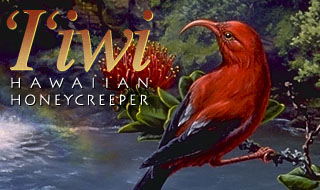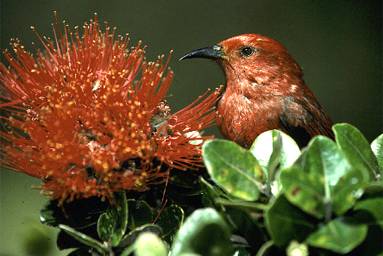| Of Hawaii's birds, the honeycreepers (Drepanidinae) are
most famous, having put on what is arguably the world's most dazzling display
of adaptive radiation--an explosion of species from a single unspecialized
ancestor to at least 54 species that filled available niches in the islands'
habitats. In fact, speciation in the Hawaiian honeycreepers dwarfs the
famed radiation of Darwin's 14 Galapagos finches. Robert Fleischer,
Cheryl Tarr, and Carl McIntosh at the National Zoo's Molecular Genetics
Laboratory estimate that the honeycreepers' ancestor arrived three to four
million years ago; others put the arrival farther back, at closer to seven
million years ago. This ancestor--one colonizing species of finch, possibly
a Eurasian rosefinch (Carpodacus sp.) or, less likely, the
North American house finch (Carpodacus mexicanus)--started what
proved to be an evolutionary snowball. "There must have been a lot of open
niches, and the birds hit the islands and speciated very rapidly," says
Fleischer, who studies the genetics of fossil and living Hawaiian birds.
Rapidly, in terms of geologic time, is thought to be within the first 200,000
to 300,000 years after the first finch touch-down.
Nectar-feeding honeycreepers evolved dramatically curved bills designed for probing and extracting the nectar from the flowers of Hawaii's endemic lobelias and other plants. Insectivorous honeycreepers developed thin, warbler-like bills for picking insects from the foliage. Seed-eaters developed stouter, stronger bills for cracking tough husks. Some species probed or cracked bark with strong hooked bills seeking wood-boring insects, thereby filling a niche woodpeckers do elsewhere. Honeycreepers shared the islands with an array of other unique bird species. In 1991, Storrs L. Olson and Helen F. James of the Smithsonian's National Museum of Natural History described for the first time 32 extinct species they identified from bones found in lava tubes, sinkholes, dunes, and excavated Polynesian refuse piles (middens) on the main Hawaiian Islands over the past 19 years. Three others had been previously described. When their analyses are through, at least 20 more species will likely be added. These recent findings conjure up a vision of an almost mythical world where birds, not mammals, dominated. Large flightless waterfowl called moa nalos were the islands' large herbivores. A harrier, a hawk, an eagle, and four owls topped the food chain as predators. No mammals patrolled the ground (Hawaii's only native land mammal is a bat), and, with the need to fly gone, many of the castaway bird species, such as endemic ducks, ibis, and rails, lost their powers of flight. But splendid isolation left Hawaii's flora and fauna ill-equipped to deal with the arrival of humans, and, as on most other isolated islands, endemic species quickly disappeared, or declined, once Homo sapiens hit the shores and wiped out flightless and ground-nesting species. |
The 'I'iwi is one of the many species of honeycreepers
that
Their movements are also unique as they spend much of
|



